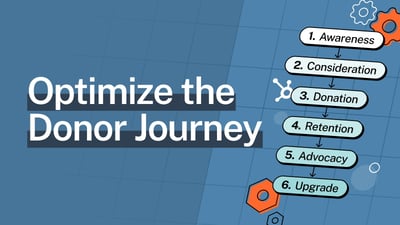How to Include Employees in Your Transformation

Welcome back. This is the second post of a three-part series on digital transformations for nonprofits.
Now that you know what bells & whistles you don’t need to transform your organization, let’s talk about what you do need.
You need invested, engaged, and nimble people working alongside you.
Let’s say you’ve already determined a need for better digital systems to achieve your mission and scale your revenue. As a nonprofit leader, your instinct might be to steer the tool selection process and reassure your team it’s all going to make sense soon.
But most people fear change, especially if they don’t feel they have a say in it. As resistance to change brews, you risk losing buy-in from the most powerful drivers of success: your people.
Many leaders underestimate the importance of properly including their employees in change efforts, or they take a top-down approach and then try to manage the change afterwards. That’s a big reason why 70 percent of transformations fail, according to McKinsey and Company.
Employees need to feel a sense of agency and personal investment to adopt a new way of thinking and working. Neglecting to understand their needs can result in hundreds of thousands of dollars invested in the wrong system/s.
I want you to be better informed from the very beginning of your digital transformation. Your mission is far too important to risk getting it wrong.
At CauseMic, we empower leaders to apply best practices from for-profit companies to accelerate their nonprofit organization’s growth. That’s why I’m sharing 3 key concepts used by for-profit companies you can apply to win the people part of your transformation and maximize your nonprofit’s potential.
Concept 1: Stakeholder Alignment
Stakeholder alignment is your opportunity to tap into the collective intelligence of your employees and gather critical information, while simultaneously empowering them to be part of the change. Your curiosity about their daily work plus their investment in a successful transformation are critical. Ideally, alignment is the first stage of your transformational journey. The following steps to stakeholder alignment are intended to inform your tool/system selection.
Make a Map
Zoom out to get a bird’s eye view of your nonprofit. List all of the functions in your organization that will either work primarily in your new digital system/s or will be impacted downstream. Examples of functions include: HR, Marketing, Fundraising, Finance, etc. I am not talking about teams per se, but rather groups that perform similar tasks. Once you have identified the functional areas, this list becomes your map to the golden treasure: alignment!
Collect Information
Now it’s time to be curious. Interview the leaders of each function; these are your stakeholders in the change. Ask them what their present pain points are and what they want and need from a new system in order to do their jobs more effectively. Take copious notes, keep an open mind, and be willing to truly listen. Employees need a voice and you need their input, so it’s a win-win when this exercise is done well.
Distill Requirements
Compare each function’s pain points and requirements to ensure they don’t have any conflicting needs. If they do, then set up a time to have an open dialogue to prioritize requirements and determine the best path forward.
Define the MVP
MVP is your Minimum Viable Product, or all of the “must-haves” from the list of requirements. This is what should determine your tool selection as well as the functionality you launch with. Plan for iterative improvements in the future to incorporate all of the “nice-to-haves” once you land the critical pieces necessary for people to do their jobs well.
Concept 2: User Adoption
A system only works if your employees learn how to use it, agree to follow new processes, and can adopt a new way of working. There are two challenges to user adoption: context and retention. We have a tested method that overcomes these challenges and cultivates cooperation, collaboration, and employee engagement.
Provide Context with Real-Time Deliverables
Learning, and oftentimes identifying, the right steps to complete tasks across functions in a new system requires real-time, hands-on contextualization.That’s why I recommend that you choose a timely deliverable such as a year-end campaign to identify, test, and document new processes in the system. Make sure you gather feedback, observations, and open questions throughout the exercise for training and future nice-to-haves.
Increase Retention with Peer-Led Training
The collaborative experience in the new system can help shape training and reveal natural leaders across your organization who seem to just “get it”. Consider empowering these individuals to assist in teaching training. Peer-led training has better outcomes and creates a relaxed learning environment where people can feel at ease asking questions or raising concerns. You’ll also want to invest in thorough documentation such as quick start guides and cheat sheets for your employees to use while they learn.
Concept 3: Reconfigure to an Agency Structure
There’s a reason that agencies excel at being creative and innovative, and it’s not just a financial one. The structure of an agency is designed for cross-functional efficiency and maximum collaboration. Nonprofits can benefit from mirroring a similar structure, especially after new digital systems are introduced.
Find A New Perspective
Instead of looking at your organization by function, try looking at it like an agency would: by the archetype of the employee and by the nature of the tasks they perform. For example: Creative, Analytics, Strategists, Project Managers, Account Executives, etc.
There are two agency structure types you can consider: Traditional and Pod. Traditional comprises larger teams of people doing the same work with head, senior, and junior roles operating in a hierarchy. Pod, on the other hand, comprises small teams of individuals with complementary skill sets collaborating on relatively equal ground. A project manager may be at the helm, but typically isn’t anyone’s direct manager in the pod.
At CauseMic, we favor the pod structure so we can easily become an extension of our clients’ teams, complementing existing capabilities and filling in the gaps as an embedded thought partner.
Reconfigure
Once you’ve analyzed how your organization could shift to working more like an agency, consider reconfiguring your teams to both simplify and sharpen your impact. An interdisciplinary team that owns an audience will increase collaboration and help minimize silos.
One of our key principles at CauseMic is “Success is not final.” The takeaway here is that you will need to continue meeting with your employees, collaborating cross-functionally to see what is working and what isn’t, and developing creative solutions when challenges arise in order to be a transformational organization with twice as much revenue as you make today. You are undergoing a culture change as much as a systems change. And since success is not final, you don’t have to get it perfect to get it right. It’s about incremental progress and a pioneering mindset.
Our Rapid Growth Framework has helped many nonprofits like yours accelerate their ROI and capture more than $200M in donations. Check it out - you can download it for free.
Watch for the final blog in this series to drop next week. I’ll give you the details on transformational storytelling and its role in your rapid growth.



